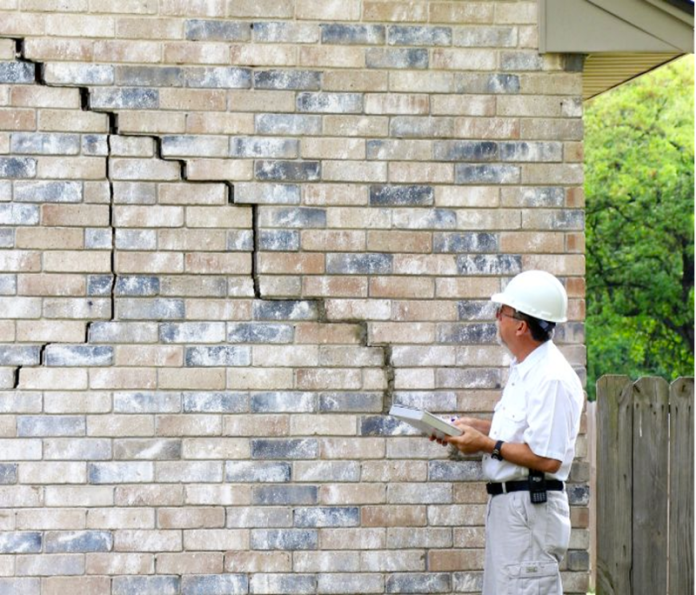Settling is a term people use to describe natural changes to home foundations over the year. The main reasons for this are time and weather. Settling is when the house gradually sinks into the soil over time. It is usual for homes to sink a little and the foundation to shift. However, it can lead to foundation damage.
Most people aren’t aware that a home settles twice. The first time happens within the first few years after it was built. This is natural and is expected since it’s a new foundation. Ongoing settlement occurs over time as the home ages. Again this is a natural process, and as long as the home is adequately maintained shouldn’t cause any issues. But, if it does then foundation crack repair is warranted.
This information is provided by our team for foundation crack repair Lansing MI. There are a few factors that determine how much the foundation will settle, such as:
Soil
If a contractor didn’t prepare the soil under the house correctly or if the clay soil expands or contracts can cause the house to sink into the ground. The soil’s density, quality of clay, and the weight of the house determine how much the home sinks.
Wood or concrete foundations
As the lumber and concrete dry, the water will evaporate, shrinking. Depending on the type of wood used affects how much the home settles. The type of concrete used, how it was mixed, and the environment all factor into this.
Weather
Where you live plays a role in how much your home settles. If you live in an area that experiences all four seasons, or one with a lot of humidity or frequent flooding, it can accelerate settling.
Changes of the season
If your home was built during the summer and fall comes with the rain, the water and humidity can cause the soil to expand and shift. If you have clay soil, it causes it to expand and contract, putting more pressure on the foundation.
What Happens to The House When It Settles?
Most of the time, when your house is settling, you won’t even notice it. However, there are times when you will see small changes, and if this happens, you’ll want to fix them to avoid issues later.
- Hairline cracks are small cracks that occur where the wall meets the ceiling. You’ll want to patch these. You can either fix these yourself or contact a contractor to have them fix it for you to make sure it blends in well with the rest of your home.
- Small cracks may appear in your foundation, and if this occurs, you’ll want to fix them, or you run the chance of getting insects and other pests.
- Air gaps may occur between the insulation and walls of your home. This can make it harder to keep your home warm or cool. These can easily be fixed by using spray form or another type of sealant.
Foundation Settlement Issues
Foundation cracks from curing concrete are expected. However, some gaps, such as foundation cracks and expansive soil, are not typical and should be fixed quickly. Foundation problems are cued due to extreme or constant foundation settling. These foundation crack repair issues cause instability in the home’s foundation. The most common reasons for this are expansion and shrinkage.
Foundation expansion
Foundation expansion is most common with foundations that use bricks. This is because brick grows flowy over time. All brick walls that are above ground expand quicker than those below ground. However, they do expand due to moisture below ground level.
Foundation shrinkage
Foundation shrinkage is the other common foundation problem. Over time concrete foundations shrink as they cure. This can cause gaps in the concrete slabs and foundation and foundation walls around your building. This is a natural process due to the chemical reaction in the concrete.
Signs of Foundation Problems
One of the first signs of foundation settlement issues is visible cracks in the foundation, these need to be repaired when they are noticed,
- Horizontal cracks in the foundation may be due to the buildup of water and soil expansion.
- Wall cracks along the wall. These frequently appear near doors and windows or under mantles. When the cracks are jagged or at an angle, it may mean there’s an issue with the structure.
- Sticking windows and doors are a sign there may be many different foundation issues. If they are difficult to open or close, your foundation may have shifted.
- Water in the basement is a clear indication the foundation has been damaged. However, sometimes water can seep in even if there’s no foundation damage, but it’s not common.
- Roof issues may also occur if there’s an issue with the foundation. If you look at the tallest point of the roof, you’ll notice cracks, gaps, or other signs.
- Gaps between the walls and framing
- Bowing or bulging walls in the basement
- Chimney cracking or leaning
- Bouncing or spongy floors, if there is also popping or creaking, you need to hire a professional to ensure your foundation is okay.
How To Prevent Foundation Problems From Occurring
Although you probably can’t prevent foundation cracks from happening one hundred percent, you can help prevent it. Foundation crack repair can cost between $300 to $600 if caught early.
- Make sure your drain system directs water away from the home. While moisture is essential for a healthy lawn, standing water isn’t.
- Make sure that your property is appropriately slanted. You want to make sure that the ground is graded so that water runs away from your home instead of towards it.
- Keep trees and shrubs far enough away so that the roots don’t grow under your home, plus trees pull moisture out of the ground, which can cause the soil to dry out.
- Add mulch and soil around the foundation to retain moisture during the summer or dry times.
- Clean and inspect your gutters to remove any debris that’s clogging them, preventing the water from draining.
- Water your foundation during dry seasons to prevent drying out.
- Routinely walk around the outside of your home to inspect it.
Is Repairing Foundation Cracks A DIY Project?
If the crack is ⅛” or smaller, you can repair it yourself. Hairline cracks are about the width of a hair and commonly appear after the first year of construction. This is normal and nothing to be concerned about. Suppose you notice smaller cracks. You want to monitor it by making a pencil mark on either side and measuring it at the widest point. If there is no expansion, then you do not need to worry. Unless moisture is seeping through, you’ll want a professional to repair the crack in the foundation if that occurs.















